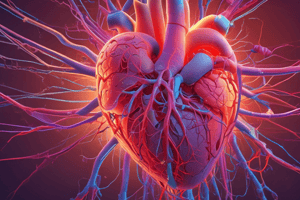Podcast
Questions and Answers
What are the two types of ganglia that drugs can act on, and what effects can they produce?
What are the two types of ganglia that drugs can act on, and what effects can they produce?
Sympathetic and parasympathetic ganglia; stimulation or blockade
Name two selective nicotinic agonists that act on ganglia.
Name two selective nicotinic agonists that act on ganglia.
Nicotine, Dimethyl phenyl piperazinium (DMPP)
What is the mechanism of action of nicotine in autonomic ganglia at low dosage?
What is the mechanism of action of nicotine in autonomic ganglia at low dosage?
Stimulates nicotinic receptor, enhances sympathetic and parasympathetic neurotransmission
What effect does prolonged exposure to high dosage of nicotine have on autonomic ganglia?
What effect does prolonged exposure to high dosage of nicotine have on autonomic ganglia?
What is the mechanism of action of nicotine on the adrenal medulla?
What is the mechanism of action of nicotine on the adrenal medulla?
What are the pharmacological effects of nicotine on the cardiovascular system?
What are the pharmacological effects of nicotine on the cardiovascular system?
How does nicotine affect the gastrointestinal tract?
How does nicotine affect the gastrointestinal tract?
What are the pharmacological actions of nicotine at the neuromuscular junction (NMJ)?
What are the pharmacological actions of nicotine at the neuromuscular junction (NMJ)?
What are the effects of ganglionic blocking drugs on the cardiovascular system?
What are the effects of ganglionic blocking drugs on the cardiovascular system?
What are the goals of pharmacotherapy for smoking cessation?
What are the goals of pharmacotherapy for smoking cessation?
Name two drugs currently utilized for reducing the craving for nicotine and suppressing physical withdrawal symptoms.
Name two drugs currently utilized for reducing the craving for nicotine and suppressing physical withdrawal symptoms.
What distinguishes the stimulation of ganglia by tetramethylammonium (TMA) or 1,1dimethyl-4-phenylpiperazinium iodide (DMPP) from that produced by nicotine?
What distinguishes the stimulation of ganglia by tetramethylammonium (TMA) or 1,1dimethyl-4-phenylpiperazinium iodide (DMPP) from that produced by nicotine?
What are the pharmacological effects of higher levels of nicotine in the central nervous system?
What are the pharmacological effects of higher levels of nicotine in the central nervous system?
What are the ganglionic blocking effects on the iris and ciliary muscles?
What are the ganglionic blocking effects on the iris and ciliary muscles?
What are the predominant tones affected by ganglionic block in the arterioles and veins?
What are the predominant tones affected by ganglionic block in the arterioles and veins?
Name two ganglionic blocking drugs.
Name two ganglionic blocking drugs.
Flashcards are hidden until you start studying
Study Notes
Autonomic Ganglia
- Autonomic ganglia can be divided into two types: sympathetic and parasympathetic
- Drugs can act on both types of ganglia to produce various effects
Nicotinic Agonists
- Two selective nicotinic agonists that act on ganglia: dimethylphenylpiperazinium (DMPP) and tetramethylammonium (TMA)
Mechanism of Action of Nicotine
- At low doses, nicotine stimulates autonomic ganglia, releasing acetylcholine and producing excitatory effects
- Prolonged exposure to high doses of nicotine can lead to desensitization and inhibition of autonomic ganglia
Effect on Adrenal Medulla
- Nicotine stimulates the adrenal medulla to release epinephrine, leading to increased glucose levels and vasoconstriction
Cardiovascular Effects
- Nicotine increases heart rate, blood pressure, and cardiac output due to stimulation of sympathetic ganglia
- Nicotine can also cause vasoconstriction, leading to increased blood pressure
Gastrointestinal Effects
- Nicotine can stimulate the gastrointestinal tract, increasing motility and tone
Neuromuscular Junction (NMJ)
- Nicotine can stimulate the NMJ, increasing muscle contraction force and hastening fatigue
Ganglionic Blocking Drugs
- Ganglionic blocking drugs can lower blood pressure, decrease heart rate, and reduce cardiac output
- Examples of ganglionic blocking drugs: hexamethonium and mecamylamine
Pharmacotherapy for Smoking Cessation
- Goals of pharmacotherapy: reduce craving, suppress physical withdrawal symptoms, and manage nicotine withdrawal syndrome
- Examples of drugs used for smoking cessation: varenicline and bupropion
Higher Levels of Nicotine in the CNS
- Higher levels of nicotine in the CNS can cause stimulatory effects, including increased alertness and arousal
Ganglionic Blocking Effects on the Iris and Ciliary Muscles
- Ganglionic blockade can cause mydriasis (pupil dilation) and cycloplegia (temporary paralysis of the ciliary muscle)
Predominant Tones Affected by Ganglionic Block
- Ganglionic blockade can decrease sympathetic tone and increase parasympathetic tone in arterioles and veins
Studying That Suits You
Use AI to generate personalized quizzes and flashcards to suit your learning preferences.



